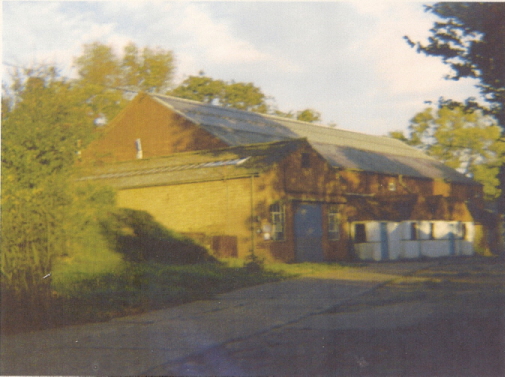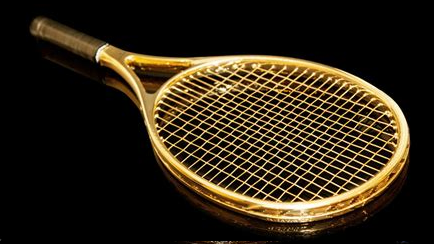

The Indoor Tennis Court was a unique building to find in a small rural village.

The Local History Group was started in 2009, with 5 original members, 3 of them researchers. Rosemary Mortham was keenly interested in the church, the school and lacemaking and when the researchers declined to write a book persuaded Leigh Axe to produce a website for them, while she ran their monthly meetings.
Rosemary was the first to put something on the website. It was headed "The Indoor Tennis Court". It had been built by William Robson, vicar of St. John's Church. The piece was not researched, but just something that was general knowledge, even though the Tennis Court had long since gone. Good to make a start with something so historic!
The land upon which the Reverend William Robson's indoor tennis court was built had been allotted in the Enclosures of Princes Risborough in 1823 to Joseph Floyd. It was already an old freehold enclosure
The Reverend William Robson purchased from Mary Grace, an orchard, previously part of the land belonging to Joseph Floyd.
Later the word got around that it had been built on Lacey Green Common. This was definitely not so. Lacey Green never had a Common. There had been a common not far from this site, but it belonged to the parish of Princes Risborough not Lacey Green. In 1823 the common was allotted to Lord George Henry Cavendish and became farmland.
William Robson cleared the land and erected an indoor tennis court. For the personal use of him and his wife. Measuring 35.5 metres by 61 metres, it was constructed in brick with skylights in the roof. The wooden floor was 'sprung' made of narrow boards to a very high standard and painted green with a special non-slip surface.
Due to their poor health it became unused and fell into disrepair.
Deeper research by Joan West to 1946 when Miles Marshall takes over the story, and a report by Winnie Wood, later Mrs Stan Rixon, who worked there for Carter's during WW2, and an update in 2021 from Ronnie & Liz Lewin on Hambye Close.

In the 1914 - 18 war the tennis racquets were put away and the army used the building as an indoor training ground. Tennis resumed after the war and was played right up until WW2.
Harold Carter had purchased 'Grymsdyke' in 1922, the same year that William Robson retired to Cheltenham. This enabled Harold Carter's timely purchase of the Tennis Court from William Robson.
The tennis court was lavishly restored. The Carters entertained the current Wimbledon stars, many playing on the court.
My sister had worked for Carters Merchants Ltd, in the City of London, an import and export company. The Carter family owned Grymsdyke House and the indoor tennis court and Mr Carter, the chairman of the company, decided to transfer the business to Lacey Green for the duration of the war.
He converted the tennis court into staff accommodation and offices. Dormitories either end for single men and single women, and offices in the middle, also a kitchen and dining room. It was the end of the building's prestigious life as a tennis court.
As you can imagine the tennis court had a very high roof. The source of heat was mainly electric and paraffin oil heaters so most of that rose and went out through the roof. A false ceiling was eventually put in and things improved a great deal.
Phyllis Adams also worked there and when I came to visit my sister, accommodation was found for me with Phyllis`s parents, Fred and Minnie Adams, who was a very friendly person and made me very welcome. I stayed there several weeks.
At this time it was difficult for companies to get staff and I was offered a job with Carters. I decided to accept, never thinking that I would still be in Bucks 70 years later.
The few married couples rented houses in the village or rooms in peoples' houses and the rest of us shared a cottage at the end of the drive. Every room was a bedroom and we still had our food cooked in the tennis court kitchen. Being the junior I was allocated the last room left which was originally a walk-in pantry, just room for a camp bed and it was quite damp. One of the older girls left soon after and I was able to share a room with my sister

Eric Boorman, whose father was Head Gardener to Carter at Grymsdyde and lived in the gardener's cottage, remembers the court well as a splendid place to play tennis. It was very well appointed with both ladies' and gentlemen's washing and changing facilities, but had a tiresome echo. He was allowed to play himself when the family were not using the court.
Mr. and Mrs Boorman vividly recall playing one Christmas when outside there was two feet of snow.
Mrs Church, who until her marriage lived with her parents, the Brown's, at The Crown, clearly remembers this echo which could be heard inside the Inn. She has helped me with much detail in this story. Miss Fagge who lived most of her life at Apple Acre in Slad Lane, also spent many happy hours playing on the court.
The Carters often held tennis parties and would entertain the current Wimbledon stars such as Hellen Jacobs
1939 Census
The Tennis Court, c/o H E Carter, 26 employees later 5 employees.
Garden Cottage 2, (This was not Court Cottage)
It was of course the last war that put a stop to all the tennis when Mr Carter evacuated his staff from the City of London to Lacey Green. Mrs Winnie Rixon writes about working there very clearly (see above).
He built an air raid shelter for the staff near Court Cottage.
It was some time before Mr Carter could get the telephone laid on to the Court and old Mr Ridgley, the Post Master from Speen, with his long white beard, could be seen daily walking to Lacey Green with the firm's telegrams.
After the war Carters Merchants returned to the City and once again the Court fell silent.
The old Tennis Court was purchased by John's the Bakers in High Wycombe, but still lay vacant.
Austin Hoy Ltd, a Canadian mining company, seeking a small factory in Buckinghamshire, advertised a reward of £50 to anyone who could put them on to a suitable premises. A Wycombe butcher claimed the reward for suggesting the Lacey Green Covered Tennis Court.
Austin Hoy had urgent Government contracts to make coal-cutting jibs, chains and sprockets for the mines. It was a time when Britain was striving for economic recovery and coal was a number one priority.
Mr W. A. Syme (now in 1986, a sprightly 84 year old, living in Princes Risborough) was employed to lay out the works, install the machinery and engage the staff. He told me that he went from house to house in the village and took on many well-known local men.
When Austin Hoy's business outgrew the Tennis Court they moved to Saunderton where they are now under the Anderson Strathclyde banner.
The old 'Court' was next taken over by Gyproc, manufacturers of plasterboard, though it was only their Contracts Department that came to Lacey Green, supplying and erecting partitions and suspended ceilings, so only stores and offices came here.
By a curious coincidence it was my daughter-in-law, at Trada in Naphill, who put me in touch with Michael Knott, then working at Gyproc, who I later discovered to have been the first editor of Hallmark.
In 1965 Gyproc sold to J. K. Taylors of High Wycombe, a much respected manufacturer of old fashioned boiled sweets. Several members of the Taylor family had been Mayors of Wycombe in their time. Like many businesses it became part of a much larger concern, Palmer and Harvey Ltd, whose speeding red vans were a daily reminder of the industrial heart of our once rural village.
Research Note
The building was used as a distribution centre and provided welcome employment, particularly for women with children, who could work flexible hours to fit in with their family life.
In 1991, in need of repair, Palmer and Harvey applied for planning permission to demolish the building and build houses on the site.
The Planning application for the Palmer and Harvey site was fraught with village comment, as Hallmark was to bear witness.
It reached the point where the continued repetition of the conflicting opinions regarding support or not prompted this Editors response:
Editor's Note: No More Letters
"Your letters on this topic have gone on throughout the whole of 1991, so we will not continue it in 1992, let's leave it to the Appeal Panel in April, but as Andrew Stone rightly says, if you have an opinion one way or the other write to your District Councillor, or straight to Wycombe Council Office, so that the Appeal gets a balanced picture of village thinking."
Comment April 1986. - Palmer And Harvey To Close
We had no idea that Palmer & Harvey were to close, last time when we featured the history of the premises. It's only a rumour, but if planning application is submitted for houses on the site, it will be a sad end to the old tennis court. It's not a pretty building, but very much part of old Lacey Green and an accepted building doing a very useful job in supplying jobs for village people. So if anyone asked us what is best for the community - 20 new houses or 20 local jobs - we should have no hesitation in saying the latter.
Report December 1990. - by Councillor Dennis Claydon
Palmer and Harvey are currently considering the future development of their site in Church Lane. One suggestion proposes the erection of twenty-four, two and three bedroom houses. Twenty of these would be for sale on the open market whilst four would be retained under a Trust, administered by the Parish Council, for first time buyers. The Company however are prepared to listen to local opinion and are anxious that the village should be consulted.
It is hoped to arrange a public meeting in the near future when positive contributions will receive due consideration.
Letter February 1991. - from Laurence Rostron
Dear Editor,
I believe that most residents in the area now know that Palmer and Harvey appear to be preparing a planning application for high density housing i.e. 20+ houses, on this site. Adjacent land/ gardens have previously been offered for sale or subject to separate planning applications.I have been advised that if planning permission for high density housing is approved for the Palmer and Harvey site then it is virtually certain that high density development approval will be given to the other site i.e., the domino effect, possibly leading to the building of 50 or 60 houses.
I have visited most residents living in Church Lane and the vast majority are against the high density project.
Can I ask you to publish my letter so that any resident who has an interest in this development and who would like to help fight what is, in my opinion, a totally inappropriate planning application can contact me for further details.
Editorial February 1991.
Every so often a section of the village becomes all steamed up about a planning application or, as at this site in Church Lane. The possibility of such an application for, to date, only a consultative draft plan for 24 very mixed development has been circulated. The protesters in this Church end of the village are suggesting only 4 houses and are afraid that other land will be drawn into the site.
The District Councillor is right pointing out that this site is redevelopment that can't be stopped but any extra land would be new development subject to planning constraint promised for this area.
We have looked again at the Village Plan and the Residents Association Village Appraisal and this draft seems to us to have got it just about right. What worries us I that the protesters may go too far and the developers could say 'to hell with it' let's re-let it with original users, right of warehouse and factory space for which they would need no planning permission and could be the worst of both worlds.
Report February 1991 - By Councillor Jean Gabbitas
I am still awaiting with interest the full application plans for the re-development of the P&H site in Church Lane. I hope that many village people will try to see them and write in, both to myself and the Planning Department of High Wycombe when the time comes.
The plan shown at a consultation meeting with your Parish Council, County Councillor, and myself showed groups of or clusters of tiny cottages, four of which might be handled by a Trust for local people, and grassy areas one of which might be handed over to the parish for a seat or swing. No extra roads cut into the site and the footpath retained. Therefore we thought the ideas worthy of further consideration.
We made our suggestions about improvements to parking and requested fewer than their original suggestion and I understand that considerable amendments have been made.
The final plans will have to enhance this 'Conservation Area' if they hope to gain approval. However, if this should happen, it will not automatically follow that surrounding gardens and fields can be developed. Re-development and change of use of an existing industrial site is quite different.
My wish for the site was always for sheltered accommodation for the elderly - it would have answered a need and generated little traffic. But I must admit that what is being proposed might attract young and old, singles and couples.
I shall give the plans careful consideration and then decide. Please take part in the process and do the same.
Letter April 1991. - from David Chalkley
Dear Ted,
In the last edition of Hallmark both you and Councillor Gabbitas commented on the proposed redevelopment of the Palmer and Harvey site. Significantly, neither of you mentions the main reason why so many people in the village are concerned about the high density development of 20 - 24 houses proposed, i.e. the extra traffic that would be generated.The Residents Association Village Appraisal highlighted road safety as the main concern of the vast majority of those who responded to the questionnaire. It also showed that the average number of cars per household in Lacey Green was already approaching 2 in 1989. There is no reason to expect a different number in Church Lane, and so a development of 20 new houses could result in 40 additional cars using the Lane and exiting onto the Main Road.
Many people from the village use Church Lane for walking with their children and dogs in a pleasant and relatively safe environment. We should take great care that we do not permanently destroy a valuable village asset, to say nothing about increasing danger on the roads, by allowing the development to go ahead in its present form.
Letter August 1991. - from Andrew D Stone
I am writing on behalf of residents of Lacey Green and Loosley Row who were disappointed to see the failure of the application for smaller houses on the Palmer and Harvey site. I wish to highlight some relevant community issues.Both villages have a majority of larger (and consequently, more expensive) houses. This means that even with the current lower house prices there are fewer younger residents in the village. Over the past five or so years this has contributed to a reduction in the number of children attending St. John's School by a complete class. Taking children from outside the catchment area has cushioned the effect of reduction of school age children living in the village, but if this trend continues it could have a detrimental effect on our local school and the community.
The provision of smaller houses would not only give our children the prospect of remaining in the village but there are also a number of local residents living in large houses who would welcome the chance to move to a smaller house without leaving the village; this would place more larger houses on the market
In Lacey Green, there is only one site where there is the possibility that smaller houses would be permitted - the Palmer and Harvey site - because there is considerable environmental gain in replacing a huge industrial building with houses. As a comparison the ground floor area of the existing buildings on the site extends to about 23,000 square feet, the proposed development (houses and garages) would have covered 10,000 square feet, giving a considerable reduction in building mass.
I do not believe that this lost opportunity was a "Threat to our village". It was a unique chance to give Lacey Green a true village centre very characteristic of many conservation areas and to contribute to a more balanced community providing continued support for local facilities.
Hopefully Palmer and Harvey will reapply with a similar density scheme but will include the changes that will be necessary to make the proposal, acceptable to Wycombe District Council. From experience neither Wycombe District Council nor Bucks. County Council are effective at enforcing restrictions on industrial activities and the reinstatement of industrial use of Palmer and Harvey could have unfortunate consequences for both residents and the community, particularly with lorry traffic on local roads.
Letter April 1992. - from Laurence Rostron
Dear Editor,
On February 26th I attended the Wycombe & District Planning Application Panel Meeting and I was delighted to hear planning approval given to Palmer & Harvey for 9 houses on their site in Church Lane. Whilst I would have preferred one or two fewer houses, I believe that the end result meets 90% of the wishes of most residents living around the site.It was without doubt, a victory for democracy and common sense and a defeat for those who support high density development with little interest in the impact on our environment.
However, the success of the evening was 'blighted' by Mrs Gabbitas who both publicly and petulantly described those of us who had dared to object to her own views as NIMBY'S (not in my back yard). I find this charge offensive and I deeply resent it.
Our objection to the original application was most certainly NOT about back yards (we all wanted this site to be re-developed). Our concern was to ensure that the environment of this beautiful old rural lane, recognised as such in the Village Plan, was not destroyed by inappropriate development.
The views expressed in the planning meeting documents by both Mrs Gabbitas and the Parish Council demonstrate that they are totally 'out of touch' with majority village opinion and I suggest it would benefit us all if they spent less time listening to themselves and more time listening to a broader cross section of village residents.
Finally I would like to thank those residents, from all parts of the village, who have supported our campaign both verbally and in writing. At times I have been almost overwhelmed by the level of this support and it is most gratifying that the original environmentally insensitive plan and its supporters have been defeated - not by NIMBY's but by residents and on this occasion a sensible District Council.
Report February 1993 - Councillor Jean Gabbitas
From Tennis Court To N. I, M, B. Y. Court?
Another Application
The saga of the Palmer and Harvey site reached the Planning Application Panel yet again when a local P. R. firm submitted an amendment to the application approved last year for nine houses. At first they attempted to get even larger houses but finally settled for nine four-bedroomed properties.Redeeming Features
The plan however has retained some of the features I requested at the start, that:
- the single access to the site be retained,
- the footpath leading to the church be incorporated as a permanent feature,
- no further house be squeezed in near Crown Cottages, and
- the trees and hedges be covered by a preservation order where appropriate and that the materials now should be traditional and in keeping with the Conservation Order (not 'nice neo-Georgian' as originally suggested).
I'm sure that when these houses are finally built and purchased the new-comers will receive the warm welcome typical of this village and that they will soon be caught up in our many activities.
:
Letter February 1994 - from Stuart King
The naming of Hambye Close continues to rumble on in your pages. I have to confess that, mea culpa, it was originally my idea which was taken up by the Twinning Committee. All the Europhobes can therefore address their hate mail to me!It is, of course, impossible to please everyone on such an issue but as the naming of a street has to go through various levels of parish and district approval, there must be others out there who think it a good idea.
Despite all the adverse comments the natives are really quite friendly and just think that after the last most recently named and in my view, unimaginatively baptised street in the village (Violet Close) you might have been stuck with Buttercup End or Poppy Way.
Researcher's Note: In March 2021 I asked Ronnie and Liz Lewin to give an update on life in Hambye Close. Liz sent the following reply.
Letter From Liz and Ronnie Lewin in Hambye Close
Hambye Close is a joyful place in which to live. The nine houses are carefully placed so that they offer as much privacy as possible. We are particularly lucky to live in the corner which gives us the advantage of a garden that goes round the house on three sides.The houses were built in 1993. There is only one of the houses now occupied by the original owners. We moved here from Beaconsfield in 2003.
At the moment there are two houses with school age children and one with a son at university.
During our time here there has always been at least one family with school age children.
It is a sociable community. Ronnie and I are the oldest (in age) residents and we feel particularly well supported by all our neighbours. If I needed help I wouldn't hesitate to knock on any door.
We definitely feel a part of a larger community but that is mainly because we are involved with some village organisations.
: